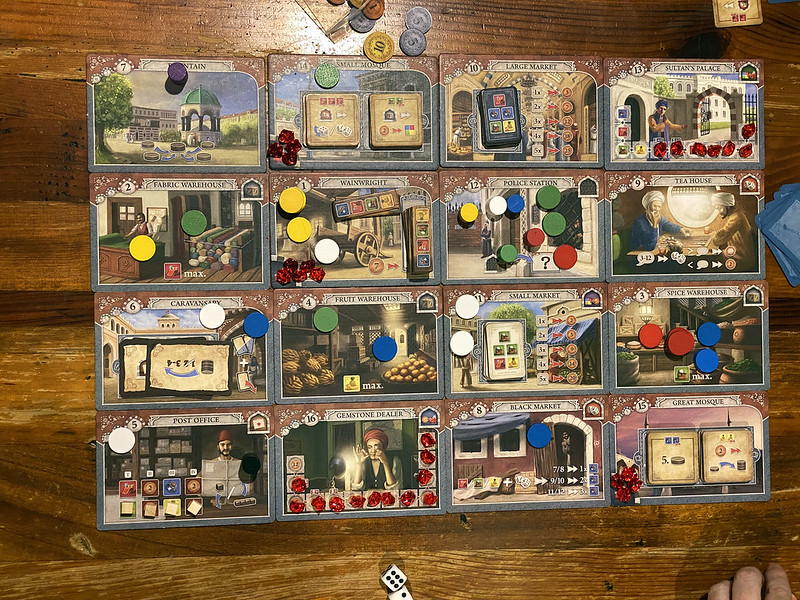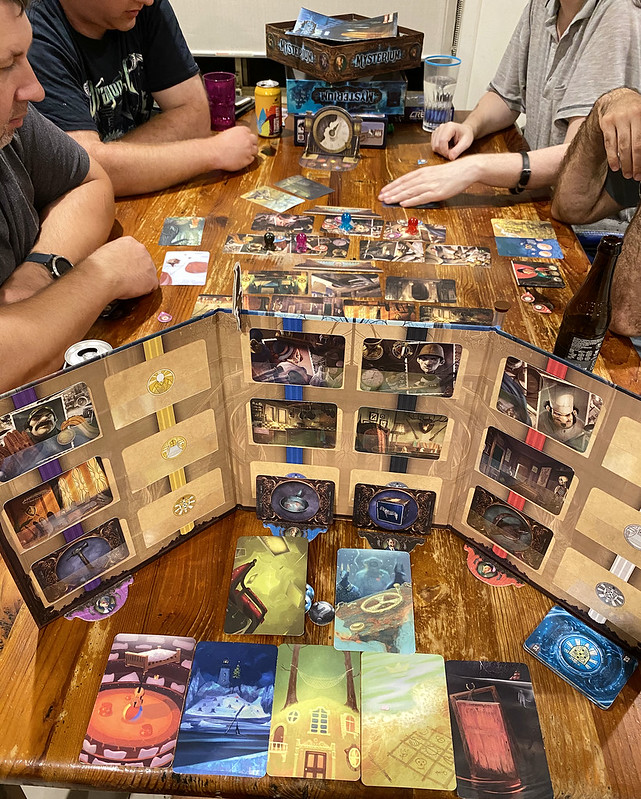Late Friday post because last night was Games Night. I arrived last this time, and everyone else was in the middle of a game of Starbase Jeff. I played this game a lot back when it was newer and really like it – it’s very strategic. But while the others finished their game, I did some Italian lessons on my iPad.
Then we got stuck into a new game (for us, but released in 2015), Istanbul.
In this game you lay out a randomised board made of 16 large tiles, representing the bazaar district of old Istanbul. Your goal is to be the first to purchase 5 gemstones. To do this, you need to move around the market, visiting various tiles. Each tile allows you to do a specific action, ranging from collecting goods (jewellery, fabric, spices, and fruit), collecting small amounts of money, selling goods to get larger amounts of money, using money to buy gemstones. Some tiles do other things to make all of this easier: the Wainwright allows you to buy larger wheelbarrows to carry your goods around in, the two mosques let you pick up small tiles that give you bonus actions to do more things, the Caravansery lets you draw special action cards which give you a one-off bonus action.
The thing that ties it all together and makes it tricky is how you move around the board. You have a large counter representing your agent, and a stack of four smaller counters as your assistants. You start in a stacked group at the Fountain. You can move up to 2 tiles, and the whole stack moves as one. To perform the action on the tile you land one, you have to remove one assistant from the stack and leave them there. So as you travel around the board on your turns, you leave a trail of assistants behind. If you land on a tile that already has one of your assistants on it, you pick them back up into your stack to perform the tile’s action. And you need to do this, because if you run out of assistants, then you don’t get to perform the action on a tile you land on, which is a wasted turn. So you’re constantly having to plan ahead, then backtrack or do little loops around the board to pick up your assistants again.
There are a few other details that add strategy and some more things you can do, but that’s the gist of the game. It was a lot of fun, and ended fairly tightly, with two people achieving the five gems and the game being decided on a tie-breaker.
After that we played Mysterium. We’ve played this several times. One player is a ghost and trying to give the other payers clues about who murdered them, so they can solve the mystery. But the ghost is very restricted, and can only give clues by handing the players cards which contain cryptic images of dream-like scenes. The players have to interpret what the ghost meant by them – and it’s very easy to go astray because each card contains many items on it.
I’ve never played this game as the ghost before, so I was keen to give it a try. It’s very challenging, but in the end I managed to clue the others to the correct conclusion, so we shared a victory.
In this photo, for example, I used the card with deep sea diver and Anubis statues to clue the racing car driver (top left on the screen) – because the wheel with spokes evoked the image of the spoked wheels on the driver’s car.
New content today:



